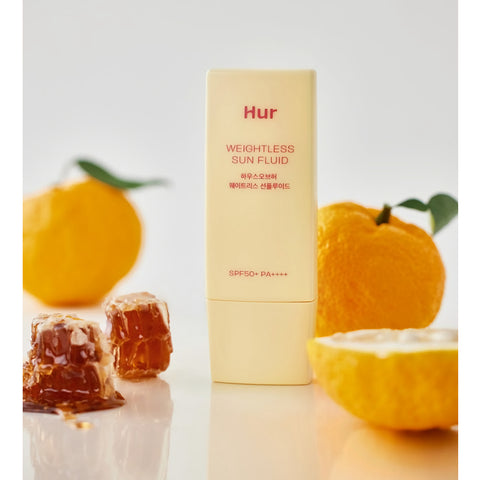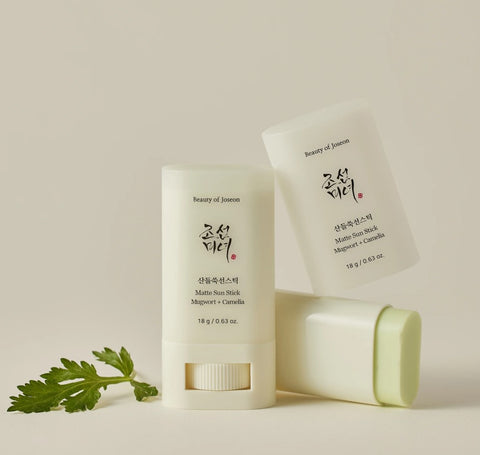Sunscreen for the face
Chemical sunscreens are usually very light and pleasant to use, and they do not leave a white layer on the skin.
Physical sunscreens are not absorbed by the skin, and are therefore often richer in texture. They may also suit sensitive skin better than chemical ones.
The Hybrid composition is typical of Korean sunscreens, which achieves a beautiful result with slight coverage, and a light and fresh composition.
95 products




![[Holika Holika] Aloe Soothing Essence Waterproof Sun Cream SPF50/PA++++](http://www.yeppo.fi/cdn/shop/products/holika_holika_-aloe-soothing-essence-waterproof-sun-cream-spf50.jpg?v=1629031549&width=480)


![[Mary&May] Vegan Peptide Bakuchiol Sun Stick](http://www.yeppo.fi/cdn/shop/files/Mary_May-Vegan-Peptide-Bakuchiol-Sun-Stick-2.jpg?v=1687949204&width=480)
![[Mary&May] Vegan Peptide Bakuchiol Sun Stick](http://www.yeppo.fi/cdn/shop/files/Mary_May-Vegan-Peptide-Bakuchiol-Sun-Stick-Texture-1.jpg?v=1687949385&width=480)
![[About Me] Be Clean Tone Up Sun (EXP. 30.9.2025)](http://www.yeppo.fi/cdn/shop/files/About-ME-be-clean-tone-up-sun.jpg?v=1685101682&width=480)
![[About Me] Be Clean Tone Up Sun (EXP. 30.9.2025)](http://www.yeppo.fi/cdn/shop/files/1000000011_detail_364_jpg.webp?v=1685101682&width=480)
![[Missha] All Around Safe Block Cotton Sun](http://www.yeppo.fi/cdn/shop/files/Missha-All-Around-Safe-Block-Cotton-Sun.jpg?v=1688719593&width=480)
![[Dr. Ceuracle] Cica Regen Vegan Sun Gel](http://www.yeppo.fi/cdn/shop/products/CicaRegenVeganSunGel_kopia_900x900_a9a1df9c-4804-4ca1-b925-4f02fd9f10a3.jpg?v=1643641160&width=480)
![[Abib] Heartleaf Sun Essence Calming Drop](http://www.yeppo.fi/cdn/shop/files/Abib_Heartleaf_Sun_Essence.webp?v=1690300925&width=480)

Physical or chemical sunscreen?
Our selection includes Korean physical sunscreens , chemical sunscreens , hybrid sunscreens and sunscreen sticks .
Korean sunscreens use both a chemical i.e. organic and a physical i.e. inorganic (mineral-based) sun protection filter. Often, to get the best result and protection, Korean sunscreens have combined both = hybrid sunscreen. In this way, a beautiful final result that slightly covers the pores is achieved, as well as a light and fresh composition.
Physical, otherwise known as inorganic or mineral sunscreen, contains minerals such as zinc oxide and titanium oxide, in the list of ingredients these can be found e.g. with the names Titanium Dioxide or Zink Oxide. Physical sunscreen scatters UV radiation away from the skin to some extent (about 5%), in addition to the fact that the composition absorbs harmful UV rays, just like chemical sunscreens. But unlike chemical sunscreens, physical sunscreens do not absorb into the skin and may therefore have a richer texture. For the most sensitive skin and babies, a physical sunscreen may be a better option than a chemical one.
Chemical or organic sunscreens are usually very light and pleasant to use, and they do not leave behind a white layer on the skin (white cast), which may make it easier to apply the necessary large amount of the product. The chemical sunscreen filter absorbs the sun's harmful UV rays, preventing them from damaging the skin. Both chemical and physical sunscreens work and last just as well, as long as they are used correctly and added often enough (a good basic guideline for the face is a teaspoon every two hours when in the sun).
Korean sunscreens
Korean sunscreen is not a concept for nothing, but there is certainly a suitable and pleasant product for everyone among these. Remember that whatever sunscreen is your favorite, the most important thing is that you apply enough of it (about a teaspoon on the face) and also remember to add more cream throughout the day 💕
SPF indicates how well the product protects against the sun's UVB radiation, but on Korean sunscreens you will also find the label PA, which is an abbreviation of the term "Protection Grade of UVA". It is a scale that measures the protection level of a sunscreen against UVA rays.
UVA rays are longer than UVB and cause less burning, but they have a significant effect on skin aging caused by UV radiation, among other things. You get the best protection against UV radiation when you choose both a high SPF and PA factor.
PA+: weak UVA protection
PA++: moderate UVA protection
PA+++: good UVA protection
PA++++: excellent UVA protection
Looking for a Korean sunscreen for the body? Every sunscreen in our selection is also suitable for use on the skin of the body, and some are available in slightly larger product sizes. But there are very few Korean SPF products on the market that are made specifically for the body. Why? Because Koreans protect their faces not only with sunscreen, but also with big hats and sunglasses. The skin of the body is thus primarily protected with clothes and even parasols, so that the sunscreen is not applied as diligently to the skin of the body. And if any part of the body is at the mercy of the sun, Koreans use the same sunscreen or even a sunscreen stick as they use for the face.







![[Frudia] Ultra UV Shield Sun Essence](http://www.yeppo.fi/cdn/shop/products/6c7a85_3f58a7104874407085d5d157bf9cbca4_mv2.jpg?v=1622884442&width=480)
![[Numbuzin] No.1 Clear Filter Sun Essence](http://www.yeppo.fi/cdn/shop/files/No.1ClearFilterSunEssence.jpg?v=1722544171&width=480)
![[Numbuzin] No.1 Clear Filter Sun Essence](http://www.yeppo.fi/cdn/shop/files/Numbuzin-No-1-Clear-Filter-Sun-Essence-2.jpg?v=1722594822&width=480)




![[Abib] Quick Sunstick Protection Bar](http://www.yeppo.fi/cdn/shop/products/Abib_sun_stick_jpg.webp?v=1676052673&width=480)
![[Abib] Quick Sunstick Protection Bar](http://www.yeppo.fi/cdn/shop/products/abib_sun_stick_how_to_use_jpg.webp?v=1676052673&width=480)
![[Beauty of Joseon] Matte Sun Stick : Mugwort + Camelia](http://www.yeppo.fi/cdn/shop/products/beauty_of_joseon_Matte-Sun-Stick.png?v=1675372626&width=480)
![[Beauty of Joseon] Matte Sun Stick : Mugwort + Camelia](http://www.yeppo.fi/cdn/shop/products/230103_MatteSunStick_Eng.jpg?v=1675372627&width=480)


![[Beauty of Joseon] Relief Sun Aqua-Fresh : Rice + B5](http://www.yeppo.fi/cdn/shop/files/2ea9fd89850243061d84fb8f81689992.jpg?v=1732268115&width=480)
![[Beauty of Joseon] Relief Sun Aqua-Fresh : Rice + B5](http://www.yeppo.fi/cdn/shop/files/boj-aqua-fresh-sun-2.webp?v=1732841547&width=480)



![[Tocobo] Cotton Soft Sun Stick](http://www.yeppo.fi/cdn/shop/products/Tocobo-Cotton-Soft-Sun-Stick.jpg?v=1679044618&width=480)
![[Tocobo] Cotton Soft Sun Stick](http://www.yeppo.fi/cdn/shop/products/Tocobo-Cotton-Soft-Sun-Stick-3.jpg?v=1679044621&width=480)
![[SKIN1004] Centella Probio-Cica Glow Sun Ampoule](http://www.yeppo.fi/cdn/shop/files/Skin1004MadagascarCentellaProbioCicaGlowSunAmpoule.jpg?v=1721980291&width=480)
![[SKIN1004] Centella Probio-Cica Glow Sun Ampoule](http://www.yeppo.fi/cdn/shop/files/Skin1004_Madagascar_Centella_Probio_Cica_Glow_Sun_Ampoule_3.jpg?v=1721980307&width=480)
![[COSRX] Aloe Soothing Sun Cream](http://www.yeppo.fi/cdn/shop/products/19db819d-ec4d-412d-9e25-fc391afcdc9f_3.jpg?v=1646824376&width=480)


![[Mixsoon] Centella Sun Cream](http://www.yeppo.fi/cdn/shop/products/CentellaSunCream.jpg?v=1657298875&width=480)
![[Dr. Ceuracle] Hyal Reyouth Moist Sun](http://www.yeppo.fi/cdn/shop/products/hyal-reyouth_moist-sun-spf50.webp?v=1666186432&width=480)
![[Dr. Ceuracle] Hyal Reyouth Moist Sun](http://www.yeppo.fi/cdn/shop/products/sun2_600x_a3e4996d-57f7-4e47-afb9-ba2704eeea3e.webp?v=1666186468&width=480)
![[Frudia] Tone-Up Base Sun Cream](http://www.yeppo.fi/cdn/shop/products/frudia_tone_up_base.png?v=1618648544&width=480)
![[Round Lab] Birch Juice Moisturizing Tone-Up Sun Cream](http://www.yeppo.fi/cdn/shop/files/round-lab-birch-moisturizing-tone-up-sunscreen.jpg?v=1727154042&width=480)
![[Round Lab] Birch Juice Moisturizing Tone-Up Sun Cream](http://www.yeppo.fi/cdn/shop/files/round-lab-birch-tone-up-sunscreen-2.jpg?v=1727415154&width=480)
![[Tocobo] Vita Tone Up Sun Cream](http://www.yeppo.fi/cdn/shop/products/Tocobo-Vita-Tone-Up-Sun-Cream.jpg?v=1679042689&width=480)
![[Tocobo] Vita Tone Up Sun Cream](http://www.yeppo.fi/cdn/shop/products/TOCOBO-Vita-Tone-Up-Sun-Cream-5.jpg?v=1679042788&width=480)
![[Kaine] Green Fit Pro Sun](http://www.yeppo.fi/cdn/shop/files/Kaine-Green-Fit-Pro-Sun-2.jpg?v=1686745799&width=480)
![[Tocobo] Bio Watery Sun Cream](http://www.yeppo.fi/cdn/shop/products/Tocobo-Bio-Watery-Sun-Cream.jpg?v=1679061753&width=480)
![[Tocobo] Bio Watery Sun Cream](http://www.yeppo.fi/cdn/shop/products/Tocobo-Bio-Watery-Sun-Cream-2.jpg?v=1679061766&width=480)
![[Some By Mi] V10 Hyal Lip Sun Protector SPF15](http://www.yeppo.fi/cdn/shop/files/some-by-mi-v10-hyal-lip-sun-protector_975898af-f7d2-43d8-b3ca-18e2ec59540d.jpg?v=1720564715&width=480)
![[Some By Mi] V10 Hyal Lip Sun Protector SPF15](http://www.yeppo.fi/cdn/shop/files/some-by-mi-v10-hyal-lip-sun-protector-model_56deab4f-70b2-47ad-89e2-8fc92982c42d.jpg?v=1720566449&width=480)
![[Frudia] Sun Care Special Gift Set - Sea Side](http://www.yeppo.fi/cdn/shop/files/frudia_sea_side.jpg?v=1722546553&width=480)
![[Some By Mi] V10 Hyal Antioxidant Sunscreen](http://www.yeppo.fi/cdn/shop/files/Some-By-Mi-V10-Hyal-Antioxidant-Sunscreen.png?v=1684907546&width=480)
![[espoir] Water Splash Sun Cream Ceramide](http://www.yeppo.fi/cdn/shop/files/WaterSplashSunCreamCeramide.jpg?v=1733424943&width=480)
![[espoir] Water Splash Sun Cream Ceramide](http://www.yeppo.fi/cdn/shop/files/water-splash-sun-cream-ceramide-mood2.webp?v=1733925761&width=480)


![[Some By Mi] V10 Hyal Hydra Capsule Sunscreen](http://www.yeppo.fi/cdn/shop/files/Some-By-Mi-V10-Hyal-Hydro-Capsule-Sunscreen.png?v=1684843576&width=480)


![[Benton] Air Fit UV Defense Sun Cream](http://www.yeppo.fi/cdn/shop/products/air-fit-uv_jpg.png?v=1650890882&width=480)
![[Axis-Y] Complete No-Stress Physical Sunscreen](http://www.yeppo.fi/cdn/shop/products/AXIS-Y_complete_no-stress_physical_sunscreen_01_sq_1000x_jpg.webp?v=1679516814&width=480)
![[Axis-Y] Complete No-Stress Physical Sunscreen](http://www.yeppo.fi/cdn/shop/products/AXIS-Y_complete_no-stress_physical_sunscreen_04_1_1000x_jpg.webp?v=1679516817&width=480)
![[espoir] Water Splash Sun Cream Fresh Cica](http://www.yeppo.fi/cdn/shop/files/espoir.jpg?v=1733424997&width=480)
![[espoir] Water Splash Sun Cream Fresh Cica](http://www.yeppo.fi/cdn/shop/files/water-splash-sun-cream-fresh-mood.webp?v=1733925891&width=480)
![[Mary&May] CICA Soothing Sun Cream](http://www.yeppo.fi/cdn/shop/products/478b18923bf99.jpg?v=1658065328&width=480)
![[Mary&May] CICA Soothing Sun Cream](http://www.yeppo.fi/cdn/shop/products/4155d9ee13faa.jpg?v=1658065328&width=480)


![[Mizon] Cicaluronic Non-Nano Sunblock](http://www.yeppo.fi/cdn/shop/products/Cicaluronic-Non-Nano-Sunblock-1.jpg?v=1622370937&width=480)






![[Huxley] Sun Essence; Stay Sun Safe](http://www.yeppo.fi/cdn/shop/files/Huxley_essencefrontpic.webp?v=1721819914&width=480)
![[Huxley] Sun Essence; Stay Sun Safe](http://www.yeppo.fi/cdn/shop/files/Hyxley_sunessence1.webp?v=1721819956&width=480)
![[COSRX] Ultra-Light Invisible Sunscreen](http://www.yeppo.fi/cdn/shop/files/cosrx-ultra-light-invisible-sunscreen.jpg?v=1721169649&width=480)
![[COSRX] Ultra-Light Invisible Sunscreen](http://www.yeppo.fi/cdn/shop/files/cosrx-ultra-light-invisible-sunscreen-2.jpg?v=1721169648&width=480)



